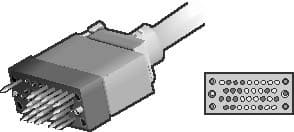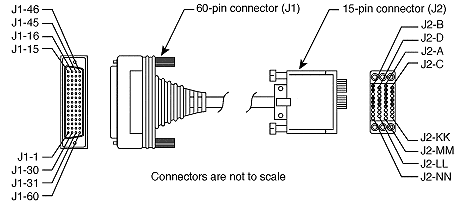V.35 stands out as a significant standard in the world of serial communication. Known for its capability to support high-speed data transfer over extended distances, V.35 has been a cornerstone in many network and communication setups. This article delves into the intricacies of V.35, exploring its technical specifications, applications, and the role it has played in advancing serial data communication. Understanding V.35 is essential for those interested in the historical and technical aspects of networking and data transmission standards.
In this article:
- What is V.35?
- Technical Aspects of V.35
- Applications of V.35
- V.35 vs. Other Serial Standards
- The Evolution and Current Status of V.35
- Best Practices for Implementing V.35
- Conclusion
- References

1. What is V.35?
V.35 is a serial transmission standard that defines a physical interface for synchronous communication between data terminal equipment (DTE) and data communications equipment (DCE). V.35 was part of the V series standards developed by the International Telecommunication Union (ITU).
V.35 supports transmissions of up to 1.544 Mbps at distances of up to 1200 meters by using balanced lines for signaling and unbalanced lines for control. The V.35 interface is typically used to connect high-speed routers to Channel Service Unit/Data Service Units (CSU/DSUs) for communication over leased lines such as T1 lines. V.35 uses a block-shaped 34-pin block connector for DTE-to-DCE connections.
V.35-to-RS-232
You can sometimes use V.35-to-RS-232 gender changers to connect V.35 equipment using 25-pin (DB25) serial cables.
Is V.35 still in use?
Although the V.35 standard was replaced by the V10 and V11 standards in 1988, it still remains in use by some installations. You can still buy V.35 cables on Amazon
CAB-V35MT Serial Cable Assembly example

2. Technical Aspects of V.35
In-depth Look at Technical Features
V.35 is a high-performance serial transmission standard that offers several notable technical features:
- Speed and Distance: It supports data transfer rates up to 1.544 Mbps, making it suitable for high-speed applications. Additionally, it can maintain these speeds over distances up to 1200 meters, significantly more than many other serial standards.
- Signal Characteristics: V.35 uses balanced voltage digital signaling. This method reduces signal interference and degradation over long distances, contributing to its robust performance.
- Physical Connectors: The standard employs a unique block-type connector, often referred to as a Winchester connector. It’s distinguishable by its size and the number of pins and sockets, designed for efficient and reliable physical connection.
Transmission Capabilities and Connectors
- Interface: V.35 is often used as an interface between data terminal equipment (DTE) and data circuit-terminating equipment (DCE), particularly for carrying network layer data.
- Connector Specifications: The connectors in V.35 are engineered for durability and to support the high-speed transmission requirements. They typically include both male and female types for different connection needs.
3. Applications of V.35
Scenarios of Utilization
V.35 has been utilized in various scenarios, primarily due to its high-speed and long-distance capabilities:
- Wide Area Networks (WANs): It’s often used in WAN applications for connecting routers and modems, where high-speed data transmission over long distances is required.
- Telecommunication Networks: In telecommunications, V.35 interfaces have been used to connect telecommunication equipment, supporting the high-speed transmission needs of these networks.
Role in Data Communication and Network Setups
- Reliable Data Transfer: V.35’s ability to transfer data reliably over long distances has made it a preferred choice in environments where data integrity is crucial.
- Network Backbone Connections: It has been instrumental in backbone network connections, facilitating high-speed communication between major network points.
- Versatility: V.35’s versatility allows it to be used in various network configurations, adaptable to different types of DTE and DCE.
In conclusion, the technical sophistication and versatility of V.35 have made it a valued standard in the world of serial data transmission. Its applications in various high-speed and long-distance scenarios underline its importance in the history and development of data communication technologies.
4. V.35 vs. Other Serial Standards
Comparative Analysis
V.35 stands out when compared with other serial transmission standards, particularly in terms of its speed and range capabilities:
- Speed: While standards like RS-232 are widely used, V.35 offers higher data transfer rates (up to 1.544 Mbps), surpassing many traditional serial standards.
- Distance: V.35 can maintain high-speed data transmission over longer distances (up to 1200 meters), which is significantly greater than what is typically achievable with standards like RS-232 or RS-422.
- Connector Type: V.35’s unique Winchester connector differs from the DB-25 connectors used in RS-232, offering a more robust and reliable physical connection.
Unique Advantages and Limitations
- Advantages: The key advantages of V.35 include its ability to handle higher bandwidths and longer transmission distances, making it suitable for network backbone applications and telecommunications.
- Limitations: However, the need for specific connectors and the emergence of new technologies offering higher speeds and more flexibility have limited the widespread adoption of V.35 in recent years.
5. The Evolution and Current Status of V.35
Historical Development
V.35 originated in the early days of computer networking and telecommunications, designed to meet the demands for higher speed data transfer over longer distances. It evolved as a popular choice for WAN connections and served as a standard for high-speed telecommunications interfaces for many years.
Current Status
- Shift to New Technologies: With the advent of newer technologies offering even higher speeds and more versatile connection options, such as Ethernet and fiber optics, the use of V.35 has declined.
- Niche Applications: Today, V.35 is primarily found in specific legacy systems or niche applications where its particular capabilities are required. It is no longer a mainstream standard in modern data transmission technologies.
V.35’s journey from a leading high-speed standard to a more niche role in today’s technology landscape reflects the rapid evolution of data transmission methods and the continual advancement towards faster, more efficient, and more versatile communication technologies.
6. Best Practices for Implementing V.35
Guidelines for Effective Use
To effectively implement V.35 in communication systems, consider the following guidelines:
- Quality of Cabling: Use high-quality cables to minimize signal loss, especially when operating near the maximum distance capabilities of V.35.
- Proper Connector Usage: Ensure that connectors are correctly and securely attached to avoid physical disconnections and data transmission errors.
- Device Compatibility: Verify that all devices in the network, including DTE and DCE, are compatible with the V.35 standard to ensure smooth operation.
Maximizing Performance and Reliability
- Regular Maintenance: Regularly inspect and maintain V.35 interfaces and connections to prevent degradation of performance over time.
- Signal Integrity Checks: Perform periodic checks to ensure signal integrity, especially in environments with potential interference or long-distance setups.
- Firmware and Hardware Updates: Keep any associated firmware or hardware updated to ensure compatibility and take advantage of any performance enhancements.
7. Conclusion
V.35, with its high-speed and long-distance capabilities, has played a significant role in the evolution of serial data transmission. Although its prominence in modern networking has waned with the advent of more advanced technologies, it remains a notable standard in the history of telecommunications.
Understanding V.35, its applications, and best practices for its implementation provides valuable insights into the development of data communication technologies and highlights the continuous progression towards faster and more efficient networking solutions.
8. References
- “Data Communications and Networking” by Behrouz A. Forouzan.
- “Understanding Data Communications” by Gilbert Held.
- “Telecommunications Essentials” by Lillian Goleniewski.
- RFC 1619 – “PPP over SONET/SDH”.
- RFC 1662 – “PPP in HDLC-like Framing”.